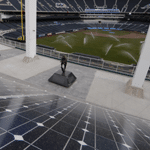No popular American sport is more driven by quantitative data than baseball. Statistics are used as metrics for success and failure, and numbers color the way players and teams are remembered. If you apply the same methodology to the environmental responsibility of baseball venues, then the home of the Kansas City Royals, Kauffman Stadium, will be remembered well.
The stadium’s new solar array produces 36,000 kilowatt-hours of energy annually, enough to power four homes for a year or, to put it more appropriately, to cook 3 million hotdogs. “We are trying to be smart about how we do things,” says Todd Burrow, the director of ballpark engineering and maintenance at Kauffman. “Thirty years ago, you didn’t pay attention to power or water usage and how much trash you created.” In the summer of 2010, the stadium went through a significant renovation that brought many of the systems up to date, and since that time, the stadium has focused on efficiency and tracking what the facility and its occupants use in regards to energy and water.
The renovation was a $250 million investment that addressed all of the aging deficiencies, including new plumbing, a sophisticated electrical system provided by Mark One Electric Company in Kansas City, a computer-controlled lighting system, and advanced wet and dry fire-protection systems.
The added technology has significantly reduced energy use, but the more important change has been cultural. “The clubhouses, the offices, food service, even how we use the scoreboard and the Water Spectacular—none of these things are used without thinking about how much energy and water it takes,” Burrow says. “We pay attention now, and it has made a huge difference in the utility bill.” The changes led to a 15 percent reduction in energy use during the first year after the renovation and an additional eight percent the following year.
The most significant and visual upgrade that the park has made is the solar array located beyond the center field wall. The 28.8-kilowatt array contains 120 solar panels and is the largest stadium solar array of any venue in major league baseball. Its impact on the stadium’s carbon footprint is equivalent to planting 107 acres of trees or reducing the carbon produced from driving 1.4 million miles in an average car.
As a way for the fans to interact with the solar technology, there is a kiosk in the outfield experience where patrons can read about the array and learn about solar energy. For Burrow, coupling the efficient engineering with the game is the best part of his job. “At the end of each day you walk out of your office and there’s a baseball game going on,” he says. “How can that be bad?”

